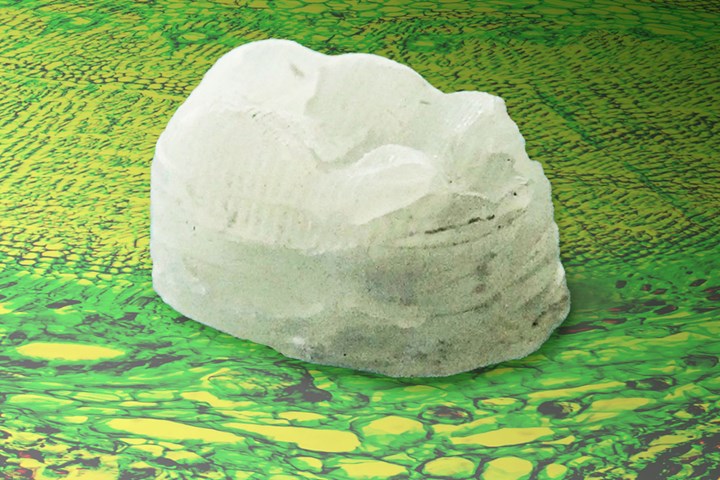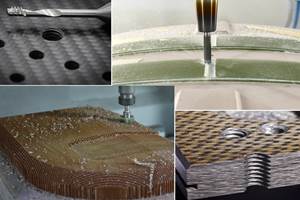MIT team engineers plant-derived composite with potential for stronger, tougher applications
Tough as bone, hard as aluminum and resembling a nacre microstructure, the cellulose nanocrystal may pave the way for naturally derived composites.

A new woody composite, engineered by a team at MIT. This image shows a tooth printed by the team resting on a background of wood cells. Photo Credit: MIT News, MIT researchers
A team from the Massachusetts Institute of Technology (MIT, Cambridge) has engineered a composite made mostly from cellulose nanocrystals (CNCs) mixed with a bit of synthetic polymer. The organic crystals take up about 60-90% of the material — the highest fraction of CNCs achieved in a composite to date, MIT concedes.
The researchers found the cellulose-based composite is stronger and tougher than some types of bone, and harder than typical aluminum alloys, such as Kevlar. The material has a brick-and-mortar microstructure that resembles nacre, the hard inner shell lining of some mollusks.
The team hit on a recipe for the CNC-based composite that they could fabricate using both 3D printing and conventional casting. They printed and cast the composite into penny-sized pieces of film that they used to test the material’s strength and hardness. They also machined the composite into the shape of a tooth to show that the material might one day be used to make cellulose-based dental implants — and for that matter, any plastic products — that are stronger, tougher and more sustainable. A. John Hart, professor of mechanical engineering and his team, including Abhinav Rao PhD ’18, Thibaut Divoux, and Crystal Owens SM ’17, have published in the journal Cellulose.
“By creating composites with CNCs at high loading, we can give polymer-based materials mechanical properties they never had before,” says Hart. “If we can replace some petroleum-based plastic with naturally derived cellulose, that’s arguably better for the planet as well.”
They found that, across multiple scales, the composite’s arrangement of cellulose grains prevented the cracks from splitting the material.
Each year, more than 10 billion tons of cellulose is synthesized from the bark, wood or leaves of plants. Most of this cellulose is used to manufacture paper and textiles, while a portion of it is processed into powder for use in food thickeners and cosmetics.
In recent years, scientists have explored uses for cellulose nanocrystals, which can be extracted from cellulose fibers via acid hydrolysis. The strong crystals could be used as natural reinforcements in polymer-based materials. But researchers have only been able to incorporate low fractions of CNCs, as the crystals have tended to clump and only weakly bond with polymer molecules.
Hart and his colleagues looked to develop a composite with a high fraction of CNCs, that they could shape into strong, durable forms. They started by mixing a solution of synthetic polymer with commercially available CNC powder. The team determined the ratio of CNC and polymer that would turn the solution into a gel, with a consistency that could either be fed through the nozzle of a 3D printer or poured into a mold to be cast. They used an ultrasonic probe to break up any clumps of cellulose in the gel, making it more likely for the dispersed cellulose to form strong bonds with polymer molecules.
“We basically deconstructed wood, and reconstructed it,” Rao says. “We took the best components of wood, which is cellulose nanocrystals, and reconstructed them to achieve a new composite material.”
Interestingly, when the team examined the composite’s structure under a microscope, they observed that grains of cellulose settled into a brick-and-mortar pattern, similar to the architecture of nacre. In nacre, this zig-zagging microstructure stops a crack from running straight through the material. The researchers found this to also be the case with their new cellulose composite.
They tested the material’s resistance to cracks, using tools to initiate first nano- and then micro-scale cracks. They found that, across multiple scales, the composite’s arrangement of cellulose grains prevented the cracks from splitting the material. This resistance to plastic deformation gives the composite a hardness and stiffness at the boundary between conventional plastics and metals.
Going forward, the team is looking for ways to minimize the shrinkage of gels as they dry. While shrinkage isn’t much of a problem when printing small objects, anything bigger could buckle or crack as the composite dries.
“If you could avoid shrinkage, you could keep scaling up, maybe to the meter scale,” Rao says. “Then, if we were to dream big, we could replace a significant fraction of plastics,with cellulose composites.”
This research was supported, in part, by the Proctor and Gamble Corp., and by the National Defense Science and Engineering Graduate Fellowship.
Related Content
European boatbuilders lead quest to build recyclable composite boats
Marine industry constituents are looking to take composite use one step further with the production of tough and recyclable recreational boats. Some are using new infusible thermoplastic resins.
Read MoreAirbus works to improve the life cycle of composites in future aircraft
This companion article to CW's September 2024 Airbus Illescas plant tour discusses recycling, LCA, biocomposites, Fast Track technologies, qualification and more.
Read MoreOptimizing machining for composites: Tool designs, processes and Industry 4.0 systems
Hufschmied moves beyond optimized milling and drilling tools to develop SonicShark inline quality control system and Cutting Edge World cloud platform for optimized tool use and processes.
Read MoreEvolving natural fiber technology to meet industry sustainability needs
From flax fiber composite boats to RV exterior panels to a circularity model with partnerships in various end markets, Greenboats strives toward its biomaterials and sustainable composites vision in an ever-changing market.
Read MoreRead Next
VIDEO: High-volume processing for fiberglass components
Cannon Ergos, a company specializing in high-ton presses and equipment for composites fabrication and plastics processing, displayed automotive and industrial components at CAMX 2024.
Read MoreAll-recycled, needle-punched nonwoven CFRP slashes carbon footprint of Formula 2 seat
Dallara and Tenowo collaborate to produce a race-ready Formula 2 seat using recycled carbon fiber, reducing CO2 emissions by 97.5% compared to virgin materials.
Read MoreAssembling the Multifunctional Fuselage Demonstrator: The final welds
Building the all-thermoplastic composite fuselage demonstrator comes to an end with continuous ultrasonic welding of the RH longitudinal fuselage joint and resistance welding for coupling of the fuselage frames across the upper and lower halves.
Read More













